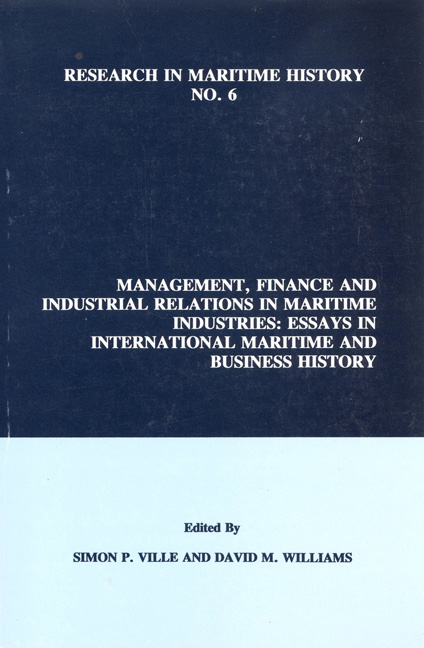 Management, Finance and Industrial Relations in Maritime Industries
Management, Finance and Industrial Relations in Maritime Industries Book contents
- Frontmatter
- Contents
- Contributors
- Introduction
- Contributors
- “Economic Theory, Information and Management in Shipbroking: Fearnley and Eger as a Case Study, 1869-1972”
- “The Early Nineteenth-Century Port of London: Management and Labour in Three Dock Companies, 1800-1825”
- “Owners and Masters: Management and Managerial Skills in the Finnish Ocean-Going Merchant Fleet, c. 1840-1880”
- “Management, Profitability and Finance in Twentieth-Century Spanish Merchant Shipping: The Compañía Maritima Del Nervion as a Case Study, 1899-1986”
- “Twentieth-Century Shipping Strategies: Broström and Transatlantic, Gothenburg's Leading Shipping Companies”
- “Contractors' Bounties or Due Consideration?: Evidence on the Commercial Nature of The Royal Mail Steam Packet Company's Mail Contracts, 1842-1905”
- “Patterns of Ownership and Finance in the Greek Deep-Sea Steamship Fleet, 1880-1914”
- “Financial Weakness and Industrial Conflict in Italian Shipbuilding Between the Two World Wars”
- “Responding to the Global Market in Boom and Recession: Japanese Shipping and Shipbuilding Industries, 1945- 1980
“Patterns of Ownership and Finance in the Greek Deep-Sea Steamship Fleet, 1880-1914”
from Contributors
- Frontmatter
- Contents
- Contributors
- Introduction
- Contributors
- “Economic Theory, Information and Management in Shipbroking: Fearnley and Eger as a Case Study, 1869-1972”
- “The Early Nineteenth-Century Port of London: Management and Labour in Three Dock Companies, 1800-1825”
- “Owners and Masters: Management and Managerial Skills in the Finnish Ocean-Going Merchant Fleet, c. 1840-1880”
- “Management, Profitability and Finance in Twentieth-Century Spanish Merchant Shipping: The Compañía Maritima Del Nervion as a Case Study, 1899-1986”
- “Twentieth-Century Shipping Strategies: Broström and Transatlantic, Gothenburg's Leading Shipping Companies”
- “Contractors' Bounties or Due Consideration?: Evidence on the Commercial Nature of The Royal Mail Steam Packet Company's Mail Contracts, 1842-1905”
- “Patterns of Ownership and Finance in the Greek Deep-Sea Steamship Fleet, 1880-1914”
- “Financial Weakness and Industrial Conflict in Italian Shipbuilding Between the Two World Wars”
- “Responding to the Global Market in Boom and Recession: Japanese Shipping and Shipbuilding Industries, 1945- 1980
Summary
After independence, a new age dawned for the Greek merchant marine. From almost 60,000 tons in 1838, the carrying capacity reached nearly 530,000 tons in 1913, an increase of almost nine-fold. In fact, one of the most impressive characteristics of the nineteenth-century Greek economy was the growth of shipping. Still, there was little relationship between domestic output and the cargoes carried by the fleet. Since Greek exports were fairly unimportant, the fleet was progressively internationalized, depending mainly on bulk cargoes, such as grain, cotton and wool, from the eastern Mediterranean and the Black Sea to western and northern Europe through commercial and maritime networks consolidated by Greek merchants and shipowners after the 1830s. It thus became an “international” tramp fleet meeting marginal transport demands in the cross-trades in an increasingly integrated international economy.
During the last third of the century, the Greek commercial and maritime network spread from Taganrog and Batoum to Marseille, London and Rotterdam, at the same time reducing its commercial activities and specialising more in shipowning. Two phases can be distinguished, identified broadly by the origins of the major shipowners: the more commercial “Chiot” period (1830s-1860s), established by men from the island of Chios, and the more maritime “Ionian” era (1870s- 1900s). The Ionian network was largely responsible for the transition from sail to steam.
Steam superseded sail in the Greek fleet by 1903 (see figure 1). A dearth of international comparisons has allowed the mistaken notion to persist that Greeks were slow to adopt the new mode of propulsion. Yet as late as 1880 no nation owned more steam than sail tonnage; indeed, seventy-three percent of the carrying capacity of the British fleet still lay below the decks of sailing vessels. In the 1880s steam surpassed sail in Britain, Germany, Spain and Belgium, while the transition occurred in the 1890s in Italy, Holland and Denmark, and between 1900 and 1910 in the USA, Norway, Sweden, Russia and Greece. By 1910, the Greek fleet was sixty-nine percent steam, compared with fifty-six percent for the USA and fifty-nine percent for Norway. Greece's transition was thus roughly contemporary with other countries.
- Type
- Chapter
- Information
- Management, Finance and Industrial Relations in Maritime IndustriesEssays in International Maritime and Business History, pp. 139 - 166Publisher: Liverpool University PressPrint publication year: 1994


